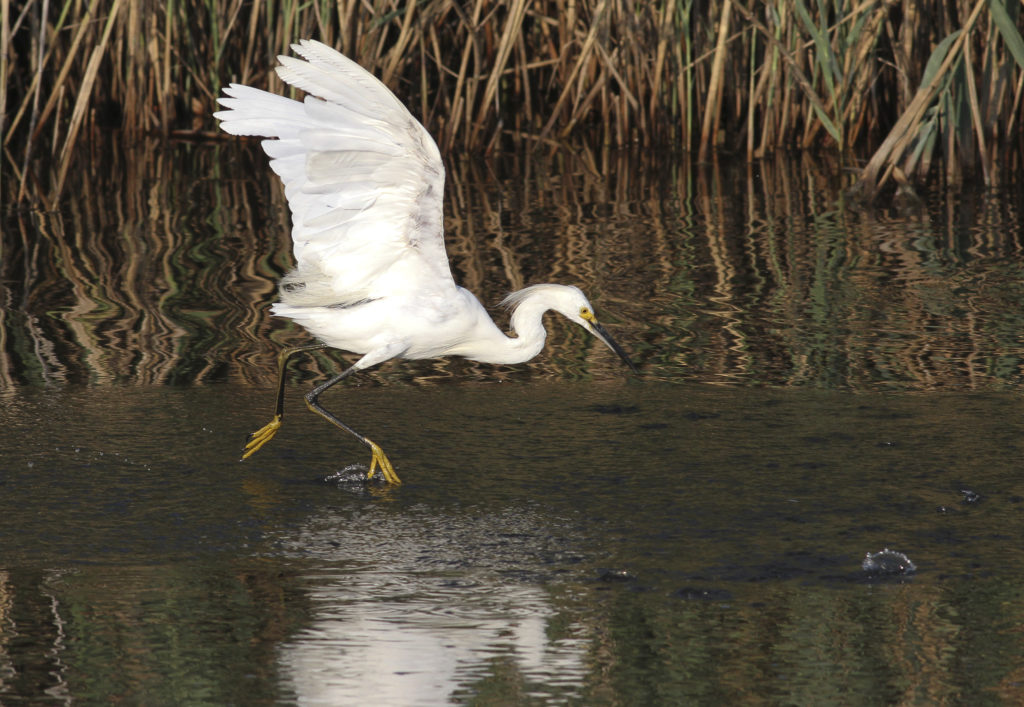Unique Fishing Styles of Birds

By Wayne Bierbaum
There are a lot of birds that prey on fish and there are just as many methods of catching fish—many are very unique.
The standard method of stabbing a sharp beak towards a fish has interesting variations. Wading birds like egrets and herons are large beaked ambush predators but the snowy egret, a small wading bird with black legs and bright yellow feet, can be seen actively, sometimes comically, running in shallow water after small fish.
In deeper water, the snowy egret frequently will fly low over a school of fish and act like it is walking on the surface. As the fish swim in front of the splashing yellow feet, the egret will lean down and grab them.
Another wading bird, the reddish egret, very frequently holds its wings open as it leans over shallow water. The open dark wings allow it to see better and also attract small fish into the wing’s shade. Then comes the quick beak action. The reddish egrets are a southern bird and rarely seen in Maryland (last appearance was in 2003).
Of the egrets and herons, the most interesting fishing method is that of the green heron, the smallest of Maryland’s herons and the most colorful. It is stalking predator that has learned how to use tools. A splash alerts minnows to an insect that has fallen in the water and they race to the sound to eat. The green heron mimics this noise by dropping a small stick into the water—the minnows rush to the sound and are caught in the heron’s beak. I have seen a green heron standing on a log on a flowing creek, take a tiny stick, its lure, and drop it into the water at the upstream end of the log and walk to the other end, pick up the stick and repeat the process over and over again. It caught a fish on just about every other drift. Green herons have also been noted to use bread crust and dried insects as bait.
The great blue heron is a classic spear fisherman. It is remarkable for how much speed and force it can generate. I have seen a great blue heron spear a good-sized largemouth bass through and through. I have much respect for that spear.
Another large wading bird that has recently started visiting Maryland has a more tactile approach to fishing. The wood stork is a tall wading bird with a dark yellow-brown beak. One of its favorite kinds of fishing involves wading in very shallow muddy or plant-filled waters. It will lean forward and stick its beak into the mud or weeds and open it, which creates a void in the mud or weeds. Without moving the beak, it will shuffle its feet toward that spot and when it feels an animal enter the void it will clamp down. They catch fish, eels, crabs, amphibians, snakes and insects doing this.
The roseate spoonbill also uses a mostly tactile hunting style. It will open its spoonbill about three quarters of an inch and while walking forward swing the bill back and forth at an angle to the bottom of shallow water. When it feels movement in the bill, it closes. The bill’s fringed edges slow the escape of any prey.
Diving birds like terns open their beaks as they hit the water, grabbing fish that are close to the surface. Small terns like the Forster’s or least terns grab fish at a depth of 6 inches. Large terns, like the Caspian tern manage about 18 inches down. They fish by sight and pop out of the water using their buoyancy like a spring. The brown pelican can fish to about 3 feet under the surface. After hitting the water in a dive, they open their bill and fill their pouch near the end of their plunge.
The diving super star is the northern gannet. They will hit the water at 60 miles per hour and penetrate to a depth of 36 feet. After the deep plummet, they may still use their wings to swim down another 20 feet. They generally are interested in sardine-sized fish and may take over 100 plunges before resting. Scientists are studying them to see how they can survive the power of those plunges without brain or bone injuries.
One of the shallowest feeders is the skimmer. Black skimmers catch fish within 3 inches of the water surface. They mostly fly at night, right at the surface with their knife-like lower bill cutting through the water. They try to rest during the day. Unfortunately, it likes to frequent public beaches. Who can rest there?
Swimming diving birds all have some idiosyncrasies. The pied-billed grebe will grab underwater vegetation with their feet to stalk fish. Loons have very dense bones that they can submerge like a submarine. They swim quite well and can stay underwater for quite a while. Their large pointed bill is used to probe crevasses for fish, crayfish and crabs. Their feet are so far back on their bodies that they have a hard time walking on land and need a lot of water surface to fly off the water. They can get trapped if they land on a pond that too small for them to fly off.
One of the best places to see wading birds, especially in early September, is Bombay Hook National Wildlife Refuge. Assateague Island also has spots with lots of wading birds and in the late fall it is a great place to witness the high-speed plunge of the gannets. They will dive into the water just off shore. Northern gannets will also come into the Bay in October and November but a boat is needed.
